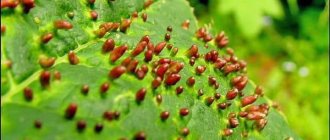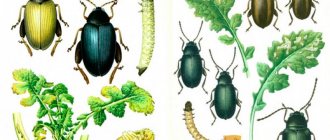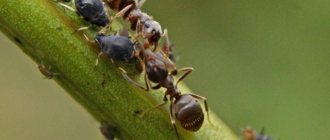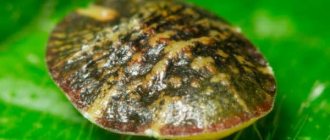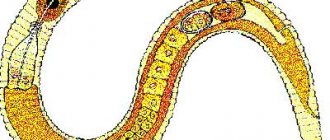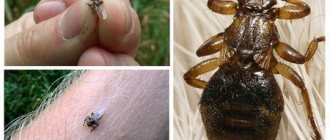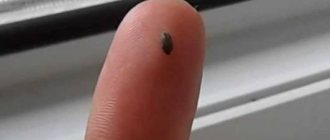Whitefly and why it is dangerous
Another name for whitefly is white midge. Among gardeners it has the nickname “white death”. Neither street nor greenhouse plantings are immune from this scourge. The pest can enter the greenhouse from the street; the conditions there are very favorable - the appropriate humidity and temperature are very popular with whiteflies and contribute to their active reproduction. In open ground there is a very high risk of re-emergence of insects, which can fly from infected plantings even to other areas.
The whitefly is considered the most dangerous cucumber pest. It lays its larvae on the back side of the leaf, its offspring are large, so in a short time it can literally infest all the bushes and destroy them. The danger lies in the fact that the insect feeds on plant sap. And in such large numbers, the parasites extremely quickly deplete the bush, after which it dies.
Recognizing a whitefly is quite simple. This insect looks like a moth. Its wings are white and its body is white and yellow. The size of the pest is not too large - only 3 mm, and its larvae reach a length of 0.3 mm. Externally, their colony resembles small yellowish scales. As soon as they are born from eggs, they immediately move on to their meal and stick to the leaf, drinking all the juices from it.
Life cycle of a whitefly
When they gain strength, pupae form. During this period, any treatments have minimal impact on them. Next, an adult whitefly emerges from the pupa. It flies to other plants, affecting increasingly larger areas.
The complexity of the treatments lies in the fact that the eggs have low susceptibility to the agents used against them.
Methods of pest control in open ground also include chemicals. In a short time they show excellent results. But they can only be used until the cucumbers bloom. It is better not to treat greenhouse cucumbers with chemicals.
To avoid the appearance of whiteflies, the fight against it must begin long before the pest appears.
Chemical control methods
Extensive damage to the area inside the greenhouse or in the garden does not allow the use of the techniques described above. Chemicals are the only methods of effective pest control that will help. The first rule is to adhere to the dosage indicated on the drug packaging. The concentration level must not be exceeded, otherwise the crop will die. List of effective drugs:
- "Akarin" is a substance with a wide spectrum of actions. Penetrates into the structure of the plant. As soon as the pest tries to feed on the sap of the seedlings, it absorbs the poison.
- "Aktara" - affects larvae and adults. Seedlings are sprayed once every 5 days.
- "Admiral" is a broad-spectrum product. It worked well when the garden was affected by a large colony of midges. Penetrates into the soil to great depth. Kills larvae, young animals, adults.
You may be interested in:
Aphids on cucumbers: causes of appearance and methods of control Aphids are a dangerous harmful insect that lives in symbiosis with ants. The presence of the latter on the site is one of the main...Read more...
The treatment is carried out in a protective suit and mask. After its completion, the used equipment is washed under running water.
Consequences of whitefly damage to cucumbers
You can detect a whitefly only by carefully examining the bush, paying special attention to the back of the leaves - this is where the pest prefers to lay its larvae.
Infected bushes can be recognized by some obvious external signs that become noticeable with a quick glance at the plantings:
- leaves and stems are covered with a sticky coating over the entire surface;
- the leaf plate is deformed, curls, withers;
- greenish or yellowish spots appear on the surface of the leaves without clear boundaries;
- larvae appear on the reverse side of the leaf;
- the fruits stop filling and growing;
- when you shake a bush, a swarm of flies flies up from it;
- the plant turns black due to the appearance of sooty fungus.
If at least one of the above signs is observed on your cucumbers, you must immediately begin processing the plantings before it is too late.
Due to the fact that the parasite sucks the juice out of the plants, they begin to slow down their growth, little nutrients are supplied, dehydration occurs, the fruits do not grow, the leaves curl and fall off. As a result, you can lose the entire harvest.
In addition, the whitefly carries various diseases on itself. It often causes chlorosis, yellow mosaic, leaf curl and necrosis. In the place where the parasite stuck to the leaf, chlorophyll can no longer be formed; this area becomes vulnerable to various pathogenic organisms.
Whitefly pest - description
With all the diversity of species of this pest, members of the family reach from 1.3 to 3 mm in length. In appearance they are somewhat similar to moth-like lepidopterans. They have a white or yellowish-red body with dark spots, and their 4 folded wings are covered with a white powdery dusty coating. Whitefly larvae, mobile at a young age, feed on plant sap. Then they are fixed on the underside of the leaves. Some types of whiteflies are dangerous quarantine pests.
How can you determine that whiteflies have settled on plants? If, when touched, white midges, similar to tiny moths, fly up, if translucent scales appear on the underside of the leaf blade - pest larvae, if chlorotic yellow spots appear on the leaves and stems of the plant, and then a sticky coating forms - honeydew, or honeydew, which is a waste product of whiteflies, and the plant lags behind in growth and development, which means it is parasitized by whiteflies.
The whitefly loves a combination of high temperature and high humidity, which is why this insect reproduces well in greenhouses and greenhouses. +10 ºC is a killing temperature for the pest, at which all its life processes cease, and only the eggs successfully survive the winter.
- Ants are not garden nurses
The whitefly is not only a dangerous pest, but also a carrier of fungal and incurable viral diseases: mosaic, curl, powdery mildew, gray rot and others.
How to deal with whitefly on cucumbers in a greenhouse
If a whitefly appears on cucumbers in a greenhouse, it is extremely undesirable to treat the plantings with chemicals, so gardeners use biological or folk remedies or mechanically remove the pest from the bushes.
Sticky tapes can be placed inside the structure so that adults flying inside stick to them. You can buy such Velcro at a hardware store, or you can make it yourself.
- Take several pieces of thick cardboard, plastic or plywood measuring 15x15 cm.
- Paint the blanks blue or yellow.
- Prepare honey, rosin, Vaseline and castor oil in equal proportions.
- Dissolve rosin in a water bath, then add all other ingredients.
- Stir the mixture, let it cool and apply to the workpieces.
- Place the finished Velcro along the entire perimeter of the greenhouse at different distances from the bushes. Pay special attention to the area near doors and windows.
Whiteflies can ignore conventional fly baits; they most readily flock to bright spots. As soon as the sticky layer on the workpiece dries, it must be removed and a fresh compound applied. To catch adult insects and prevent them from breeding, you need to thoroughly shake the bushes several times a day. Fumigators and mosquito repellent plates can be used as a preventive measure. During their operation, it is necessary to tightly close the doors and windows in the greenhouse.
When larvae are discovered, some gardeners begin to wash them off the leaves. But when they fall into the ground along with drops of the solution, they do not die, but grow up safely, again moving to the bush. Some particularly desperate gardeners even use a vacuum cleaner to suck up the pests. But this often leads to serious damage to the vegetative parts of the plantings.
Insect activity decreases at air temperatures below +10 °C, but as soon as it gets warmer, they will return to their usual way of life, but cucumbers are unlikely to survive such changes.
Traps: 2 ways to get rid of whiteflies on cucumbers
Simple traps help catch adults, which helps reduce their population in the area. You can make them yourself from scrap materials:
- A small plastic bottle needs to be painted bright yellow or blue, a sticky mixture of Vaseline and laundry soap should be made and the entire surface of the bottle should be covered with it. Such traps are suspended under the roof of the greenhouse at a short distance from the leaves of the plants. This measure will attract more insects.
- Take a red or yellow light bulb; if you don’t have one, then paint a regular one in the appropriate color. Connect it to electricity and place it in a small wooden box - it will serve as a lampshade. Hang an improvised lamp under the roof of the greenhouse or on a support near the garden bed, and place a wide container of water under it. Insects that fly into the light will receive burns from the hot bulb and fall into the water.
Reference. In a greenhouse, using special traps, you can destroy up to 80% of all adult whiteflies, especially if all the bushes are periodically shaken.
11 folk recipes for whiteflies on cucumbers (table)
The table below shows the main recipes for folk remedies that help fight whiteflies.
| Component | Methods of preparation and use |
| Tobacco | Tobacco sticks are used to process greenhouses. The doors and windows of the structure must be tightly closed, after which the checker is set on fire. Work should be carried out only in a protective suit, respirator and gloves. It will be possible to open the greenhouse no earlier than after 5 hours. Cucumbers can be treated with tobacco infusion made from tobacco from 10 cigarettes and 1 liter of boiling water. The solution is infused for about 5 days and topped up to a volume of 2.5 liters, after which it is filtered. Re-treatment is recommended every 3-5 days. |
| Laundry or tar soap | To prevent the insect from laying its larvae on the leaf, it is wiped on both sides with a solution of laundry or tar soap diluted in water in a ratio of 1:6. For better dissolution, it is recommended to first grate the soap on a fine grater. Usually, two treatments with an interval of 1 week are enough to prevent the appearance of pests. The same composition can be sprayed on the bush itself and the soil around it. |
| Vinegar essence | Plants are sprayed with 70% vinegar diluted in water at the rate of 1 tbsp of the substance per 1 liter of water. The procedure is repeated daily until the insects are completely destroyed. |
| Sugar solution | A sugar solution prepared at the rate of 250 g per 1 liter of water is sprayed onto the leaf blades affected by the pest. They are covered with a thin film, which must be carefully washed off after about 5 days. If the first treatment does not give the desired results, it must be repeated after 7 days. |
| Garlic | For every liter of water you need to take 1 good clove of garlic. It is finely chopped or passed through a press and filled with water. The solution should sit in a darkened room for a day, after which it should be used to spray the plantings every 5 days. |
| Yarrow | To prepare herbal infusion, yarrow is crushed and used at the rate of 100 g per 1 liter. The grass is poured with water and left for 3 days, stirring occasionally. This treatment is carried out once every 7 days. |
| Dandelion | Leaves and roots in an amount of 100 g each are finely chopped and filled with water (2 l). The solution should sit in a dark place for at least 4 days. After this, it is filtered, and the resulting composition is treated three times with an interval of 5 days by spraying. |
| Potassium permanganate | 3 g of crystals are poured with water (10 l), stirred until completely dissolved and the bed is watered. To prevent the appearance of the pest, weekly treatment is sufficient. |
| Benzyl bezonate | Add 60 ml of benzyl benzonate to 1 liter of water, stir and spray the plantings weekly. |
| Lemon | Lemon peels in the amount of 150 g are poured with water (2 l) and left to infuse for 2 days. After time, 40 g of pre-grated laundry soap are added to the solution. The composition is used for mechanical processing of sheet plates. |
| Solution based on turpentine oil (turpentine) | To prepare the solution you will need: 30 g of laundry soap, 30 ml of camphor oil, 25 g of dry yeast, 50 ml of turpentine, 10 ml of eucalyptus tincture, 1 tbsp. ammonia solution (ammonia). All components are mixed together and diluted with water in an amount of 5 liters. For a large area of plant damage, treatment is carried out 3 times with an interval of approximately 5 days. |
Natural enemies of whiteflies
Whiteflies have natural enemies in the wild that control the growth of the insect population. These include ladybugs and lacewings. They are attracted to garden flowers, especially marigolds, which can be planted close to the beds. But such a preventive measure does not give quick results, because there is no guarantee that ladybugs will settle en masse on the site.
Encarzia
On an industrial scale or during a whitefly invasion over a large area, it is recommended to use encarsia. You can buy them in large specialized stores. The number of individuals depends on how many whiteflies are in your area. In case of severe infestation, there should be one encarsia for every 15 larvae. They are released into the greenhouse a couple of weeks before planting so that this miniature wasp can destroy all enemies. By the way, this insect can smell a beetle larva at a distance of 20 meters.
The only difficulty that beneficial insects face is the villi on cucumber leaves, due to which it is not always possible to reach the larvae.
Macrolophus bug
Another enemy of pests is the polyphagous macrolophus bug. Most often it is used in greenhouses and greenhouses. It helps fight not only whiteflies, but also aphids, spider mites and thrips.
Plants
Ageratum
Another effective way to overcome the parasite is to divert its attention to a more attractive plant.
More than cucumbers, whiteflies love ageratum flowers and American weed. But they not only attract insects, but also have a sterilizing effect on them. If an adult pest drinks such juice, it will no longer be able to lay eggs and give birth to offspring. These plants can be planted close to the cucumbers, but not in the beds themselves, but in separate pots.
6 biological preparations for whiteflies on cucumbers
Biological preparations help fight whiteflies in large numbers of the pest, when folk remedies do not give the desired results. The table below describes the most effective of them.
| Name | Characteristic | Mode of application |
| Aktofit | The active ingredient of the drug is aversectin. It enters the body of whiteflies along with the juice and paralyzes the nervous system of the pests. Actofit is produced in the form of a dark brown or yellowish liquid; in stores you can buy a packaged drug or take a large canister or bottle at once. Effectively fights against whiteflies that attack greenhouse plantings of cucumbers, eggplants and tomatoes. It affects not only adults, but also larvae with eggs. | 6 ml of the drug is diluted in water to a concentration of 0.6%. Treatment is carried out twice at intervals of a week. The product works especially effectively if the treatment is carried out using fine sprays, for example, through a cold fog installation. The waiting period is 2 days. |
| Bitoxibacillin | The main active component of this intestinal pesticide is the bacterial strain Bacillus thuringiensis var. thuringiensis. The substance has a powdery structure and is sold in metered packages weighing 100, 50, 25 or 10 g. You can buy large packages weighing 10 or 20 kg. Bitoxibacillin, getting inside the insect, leads to the penetration of the alkaline filling of the intestine into the body cavity. This process ends in septicemia, resulting in the death of the whiteflies. | Spraying of bushes is carried out at the moment when insects begin to emerge from the larvae. Usually, only two sprayings with an interval of 5-6 days help get rid of the pest. The drug is diluted at the rate of 100 g per 10 liters of liquid. You can start collecting fruits only after 5 days. |
| Akarin (Agravertine) | The main component of the drug is Avertin N. It has a detrimental effect on the nervous system of insects, blocking the process of transmission of nerve impulses. The main advantage of Akarin is that insects do not develop resistance to the drug. It is effective in treating plantings not only against whiteflies, but also against mites and nematodes. | Processing is carried out during the growing season of cucumbers. The solution is prepared at the rate of 16 ml of the drug per 2 liters of water. This amount is quite enough to spray 1 sq.m. landing The total number of treatments is 3 times. You can harvest in 2 days. |
| Verticillin | The product has a liquid formula and a specific composition, which includes mycelium and spores of the entomopathogenic fungus Verticillium lecanii. The drug is sold in liquid form, packaged in bottles of 5, 1 or 0.5 liters. Verticillin is effective in controlling whiteflies at different stages of their development, except for the pupal stage - during this period the insect is not susceptible to treatment with the drug. | The solution is prepared by mixing 100 ml of the substance and 10 liters of water. Treatment is carried out at least 4 times with an interval of 10-12 days, so as not to miss the stage of larvae or eggs. When spraying, special attention should be paid to the back side of the leaf plate, where pests most often lay their future babies. If there are a lot of whiteflies, then it is necessary to make the solution more concentrated. To do this, dissolve from 200 to 500 ml of Verticillin in the same amount of water, and spraying is carried out weekly. |
| Fitoverm | The main active ingredient of the drug is aversectin C, which is a mixture of waste products of the fungus Streptomyces avermitilis. They have a paralyzing effect on the pest’s body; insect death occurs within 24 hours after treatment. | To prepare a solution for 1 liter of water, take 10 ml of the drug. Spraying is carried out every 1-3 weeks, regardless of whether cucumbers are growing in a greenhouse or outside. The frequency of repetitions depends on the extent of the infection. For 10 square meters of planting, about 1 liter of ready-made solution is enough. This insecticide is good because it is not addictive to insects, so it can be safely used several times throughout the season without losing its effectiveness. Complete dissolution of the components occurs within 48 hours, which makes it possible to use the product several days before the start of harvesting. |
| Biotlin | This insecticide comes in two types: Biotlin VRK - 20% imidacloprid concentrate in 1.5, 3 ml ampoules or 9 ml bottle; Biotlin BAU is a 10% imidacloprid concentrate, available in a 0.7 liter bottle equipped with a special convenient sprayer. The components of the drug easily enter the vascular system of the plant and are distributed throughout all its vegetative parts along with the juice. The pest, drinking it, receives a lethal dose of a substance that causes complete paralysis. Then convulsions occur and the pest dies. | During the period of active growth, cucumber is sprayed. To prepare a solution, Biotlin VRK is diluted at the rate of 5 ml per 10 liters of water. For 10 sq. m of beds, 3 liters of the prepared mixture is enough. Biotlin BAU is sold ready-made; a quantity of 0.7 liters is enough to spray 7 sq.m. beds. One treatment per season is enough, the harvest can be harvested after 3 days. |
If you follow all the instructions in the instructions, then biological preparations will not harm your cucumbers even during the period of active fruiting. Spraying should be carried out in the evening or morning hours, when sun activity is minimal. The leaves need to be thoroughly processed on both sides, paying special attention to their lower part. Do not forget to water the soil in the garden bed with insecticides while processing the plants; insects that have fallen from the bush may also be present there.
Harm from whiteflies
This pest loves heat very much, so most often the whitefly is found on cucumbers in greenhouses and hotbeds. She is rarely seen outdoors. The insect consumes plant sap in fairly large quantities. She secretes the excess in the form of honeydew. It, in turn, becomes an environment in which various harmful microflora multiply, such as fungi, bacteria, etc. The presence of a sticky black coating on the surface of the plant, left by the whitefly, has a negative effect on the processes of photosynthesis, and the plants lose their attractiveness. After some time, the cucumber bushes become weak and lifeless. You can see how the inflorescences are damaged, and there are fewer formed fruits. The sticky layer attracts other insects, such as ants. The whitefly lays eggs, and their numbers gradually increase.
Features of the fight against whitefly on cucumbers in open ground
Processing cucumbers in open ground is carried out using the same methods as in a greenhouse. The only difference is that when planting outdoors, the range of means used expands - chemicals can be used there. They are characterized by high speed of action and efficiency. Chemicals destroy whiteflies even in large numbers. Some of them help destroy insects at the egg and larval stages.
11 chemical remedies for whiteflies on cucumbers
When traditional and biological drugs do not give the desired result, we have to resort to heavy artillery - the use of chemicals. We have listed the most effective and safest of them in the table below.
| Name | Characteristic | Mode of application |
| Aktara | The active component of the drug is thiamethoxam at a concentration of 250 g/kg or 240 g/l. Aktar has both direct and indirect effects on pests. | For spraying, 2 g of the substance is diluted in 10 liters of water, and for irrigation, its amount is doubled. Treatment should be carried out until the flowers appear once per season. |
| Aktellik | The drug belongs to the organophosphorus insecticides. The active ingredient is pirimiphos-methyl, its dosage is 500 g/l. | To prepare a solution, 3-4 ml of the substance are diluted in 1 liter of water. Depending on the scale of infection, for every 100 sq.m. 5 to 15 liters of the finished solution are consumed. Spraying is carried out twice with an interval of 5-7 days. The effect of one treatment lasts up to 2 weeks. If necessary, you can re-spray. |
| Alatar | The drug has two main active ingredients – malathion and cypermethrin. The composition is supplemented with antioxidants, surfactants, solvent and stabilizer. You can purchase the product in the form of a solution (50 ml bottle) or concentrate (5 ml ampoule). | Processing of cucumbers should be carried out no later than 20 days before the start of harvest. Consumption for 100 sq.m of plants is 4 liters of working preparation. To prepare it you will need 5 ml of Alatar. |
| Arrivo | The active ingredient of the product is cypermethrin. It gets inside the bush and spreads with the juice along the leaves and stems. Pests, having tasted the poison, die within half an hour due to paralysis. The drug is sold in concentrated form in small ampoules of 1.5 ml. | The contents of one ampoule are diluted in 10 liters of water. The effect lasts from 10 to 14 days. |
| Bona Forte | The active ingredient of the drug is natural pyrethrum. The solution is available in ready-made form. The bottle is equipped with a sprayer. A significant advantage of the chemical is the absence of addiction on the part of whiteflies. In addition, Bona Forte does not accumulate in plants and soil, thereby causing no harm to the environment or humans. | The product is used for spraying cucumber plantings. It must be sprayed from a distance of at least 30 cm to the leaves. Paying special attention to the reverse side of the sheet. If insects are also present in the garden bed, the soil on it must also be treated. |
| Decis | This chemical has a contact-intestinal effect. It is produced in three types: Decis Profi - granules for dissolution in containers of 6 kg or in bags of 1 g, Decis Expert - concentrated emulsion in volumes of 2 ml, 100 ml, 1 or 5 l, Decis Lux is an emulsion with an improved formula, packaged in 1 or 5 liter containers, 5 ml ampoules. | The working solution is prepared at the rate of 0.35 g of product per 5 liters of water. This amount is enough to spray 100 sq.m of plantings. Treatment is carried out before flowering during the period of active growth. |
| Inta-Vir | This drug belongs to the category of peritroids, which in their formula repeat natural insecticides. The active ingredient is cypermethrin. Inta-Vir is available in two forms: white tablets for dissolution in water in the amount of 8 pcs. packaged, powder weighing 8 g in each sachet. | No more than 3 treatments can be carried out per season. To prepare the solution, each tablet is diluted in 10 liters of water. |
| Iskra M | The active ingredient of the product is malathion (it is also found in the drug Karbofos). It remains in the plant for a long time, so you need to start processing at least 2 weeks before harvesting the cucumbers. | Prepare a working solution: 5 ml per 5 liters of water. Next, 1 liter of working solution is sprayed per 10 sq.m. |
| Confidor | The drug belongs to the class of neonicotinoids, the active substance is imidacloprid at a dosage of 70%. Confidor is presented by the manufacturer in the form of water-dispersible granules with a mild odor, brown color. You can purchase the product in containers of different weights - 1 g, 5 g, 400 g. | Treatment is carried out once after a colony of whiteflies is detected on the plantings. To prepare the solution, only 3.5 g of the drug is enough, this amount is enough to treat 100 sq.m. When spraying, the same amount of area will require from 10 to 30 liters of working solution. |
| Talstar (Bifenthrin) | The main component of the drug is bifenthrin. The drug is available only in the form of a concentrated emulsion. | Effectiveness after treatment remains for 2-3 weeks, which is important to consider when planning harvest. For every liter of water, add 0.6 ml of concentrate. |
| Tanrek | The drug is available in the form of a water-soluble concentrate. The active ingredient is imidacloprid. For large-scale plantings, the manufacturer offers a 1 liter package, and for small areas a container of 10 or 50 ml or a 1.5 ml ampoule is sufficient. | To prepare the solution, 5 ml of the drug is dissolved in 10 liters of water. Treatment is carried out once, the duration of action is 4 weeks. |
When working with chemicals, you need to take into account the fact that they cannot be stored in diluted form; they must be used immediately after preparation. Those products that require repeated treatment must be used at intervals of at least 5 days.
Spraying is carried out only during the period of vegetative growth; chemicals are destructive for flowers. Information about how much time should pass from the last treatment until the flowers appear and harvest is always indicated on the product packaging.
Spraying of cucumbers is carried out early in the morning or in the evening after solar activity decreases. Pay close attention to the weather forecast. In order for the result to be as effective as possible and last a long time, there should be no rain in the next three days after carrying out the work to destroy insects. If possible, not only the cucumber plantings are processed, but also the plants adjacent to them, if they do not yet have flowers and fruits, and the soil is also watered in case there are insect larvae there.
You cannot use the same product more often than the period specified by the manufacturer. Whiteflies develop resistance to active substances, and the effectiveness of treatments decreases. Therefore, all drugs used must be alternated.
Once flowers bloom or fruits appear on cucumbers, chemicals can no longer be used. During this period, you can use biological or folk remedies to control pests.
Important! Be sure to protect your face and hands during processing. The solution should not be able to get on the skin or mucous membranes. It is better to dispose of clothing and gloves after spraying.
How to make an effective whitefly trap?
You can also make such a cunning trap for whiteflies - it is unexpectedly very effective:
Step 1. Paint the pieces of plastic orange-yellow.
Step 2. Next we cover them with entomological glue.
Step 3. We attach the lighting directly to the plastic, which we hang at the level of the tops of the plants.
In just an hour, up to 80% of all whiteflies will stick there. And at night, set a second trap:
Step 1. We drill holes in the box at the level of the light bulb - and we place it inside the box. Step 2. We also paint the light bulb orange-yellow.
Step 3. Under the light bulb, at the bottom of the box, place a container of water. The principle of operation of the trap is as follows: whiteflies strive for this light at night, get inside the box, fly, get burned on the light bulb and fall into a container of water. They don't know how to swim.
